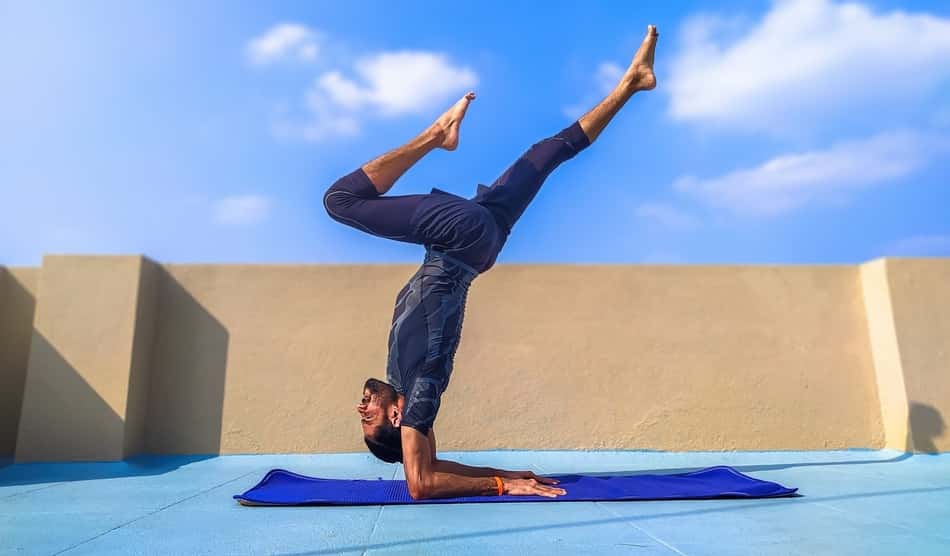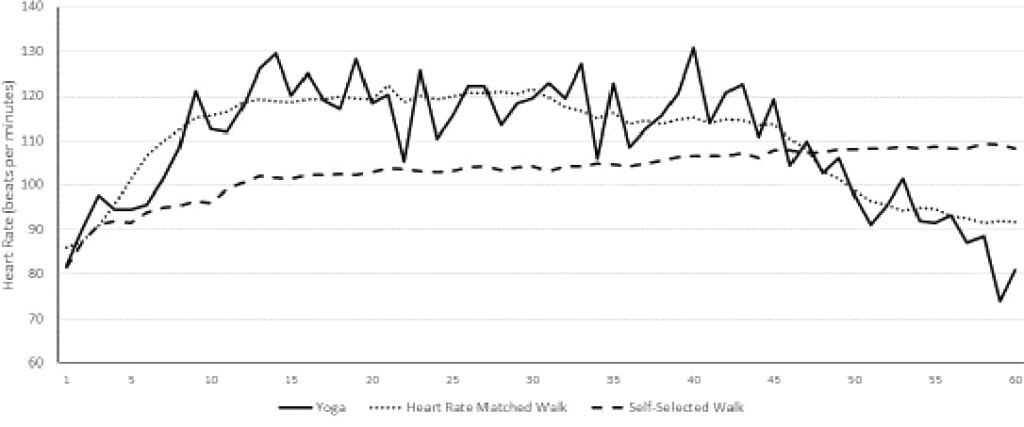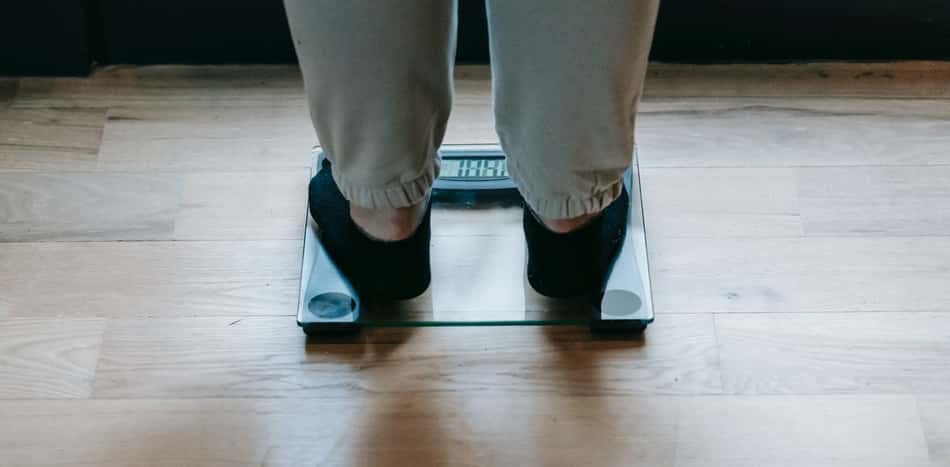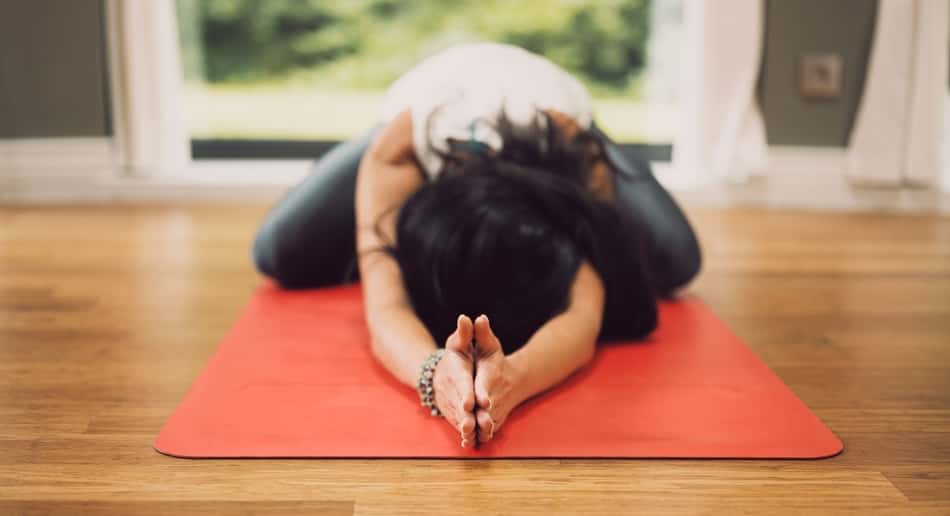In this article, I will be comparing walking with yoga based on the current research and help you decide which one is better.
In general, walking is better than yoga in the terms of metabolic effort and energy expenditure. However, some elements of a yoga sessions, like sun salutation, yielded similar results and equally meet current guidelines for improving, or maintaining cardiovascular fitness.

But there is so much more to consider because you also need to value other important factors like personal goals, fitness level, and mobility.
Walking or Yoga For Weight Loss
In the perfect world, we would have time and energy for both. But in the real world, when you are crunched on time, and you need to choose between yoga or walking, which one is better?
Is walking or yoga better to lose weight? In general, for weight loss walking is better than yoga because 60 minutes of walking burn more calories than the equivalent of a yoga session. Walking keeps the heart rate elevated for 60 minutes, whereas one-third of a yoga session is meditation, which significantly lowers the heart rate.
Take a look at the study done by Dr. Sally A Sherman from the University of Pittsburgh in Pennsylvania. She documented a group of 38 people doing sessions of vinyasa yoga and compared its effects with walking. The study was designed to measure energy expenditure via indirect calorimetry (source).
What is indirect calorimetry? Indirect calorimetry is a gold standard method to measure energy expenditure in clinical settings. It estimates respiratory gas exchange (how much oxygen is consumed and how much carbon dioxide is produced) through the mouthpiece attached to the measurement device.
The study was divided into three sections where each of the participants did as follows:
- Vinyasa yoga
- Treadmill walking at a self-selected brisk pace
- Treadmill walking at a pace that matched the heart rate of the Vinyasa yoga session
In the graph below you can see a comparison of heart rate.

Looking at this graph we can notice some of the early conclusions:
- Vinyasa yoga sessions have a number of fluctuations in heart rate where it peaks at above 130 bpm.
- After the 45-minute mark, it goes down until reaches a baseline of below 80 bpm at the end of 60 minutes.
- Self-pace walking has the lowest overall heart rate, however, it peaks at the 10-minute mark and maintains a similar level throughout the entire 60-minute time.
- Walking at a pace that matches the heart rate of yoga sessions has a similar trend to Vinyasa.
The results showed that peak heart rate was higher in the Vinyasa yoga session. This means that during the class, there had to be some challenging poses that called for intensity.
But what about the energy expenditure?
The expenditure was significantly lower in the Vinyasa yoga session, compared to both walking at own pace, and walking to match the heart rate.
Here are the results.
| Activity | Vinyasa yoga | Self-selected pace | Matched with vinyasa yoga |
|---|---|---|---|
| Heart rate | 109 | 103 | 109 |
| Energy expenditure | 273 kcal | 325 kcal | 353 kcal |
| Rating of perceived exertion | 13.7 RPE | 11.9 RPE | 12.6 RPE |
Key takeaways:
- The yoga session had a higher heart rate. However, because of inconsistency and drop in the last 15-minutes, the number of total calories burned was lower, compared to walking.
- The self-paced walking session had a lower, but consistent heart rate throughout the whole 60-minutes, which resulted in more calories burned in total.
This is a real-life example because in the typical yoga session you do have a long “cooldown” where people usually lay down, relax, and meditate in savasana pose. This downtime makes a difference in energy expenditure if we compare both activities minute by minute.
Related article: Click here to learn more about how I lost weight by “walking 10km a day“
TIP: If your goal is to burn the most amount of calories with yoga, simply extend the asana part of the session, and bypass the meditation part where the heart rate goes down.
What Burns More Calories, Walking Or Yoga?

In general, walking burn more calories than yoga because during walking heart rate is constantly raised, whereas in yoga class the first 5-10 minutes consist of breathing, and the last 20-30 minutes is slow-pace meditation, which lowers the overall calorie cost.
Here you can see details in walking variations, by sample body weight. On the left side you have 14 different variations of walking and the equivalent of calories burned for individuals who weigh 130 lbs, 160 lbs, and 200 lbs.
The information was taken from the Compendium of Physical Activities (source).
| Walking | 130 LBS | 160 LBS | 200 LBS |
|---|---|---|---|
| Less than 2.0 mph, very slow | 124 | 153 | 191 |
| Carrying a child or a 15-pound load, slow walking | 143 | 176 | 220 |
| 2.0 mph, slow pace | 174 | 214 | 267 |
| Walking a dog | 186 | 229 | 286 |
| 2.5 mph, moderate pace | 186 | 229 | 286 |
| 2.5 mph, downhill | 205 | 252 | 315 |
| 2.8 to 3.2 mph, moderate pace | 217 | 267 | 334 |
| 3.5 mph, brisk walk | 267 | 328 | 410 |
| 4.0 mph, a very brisk pace | 310 | 382 | 477 |
| 2.9 to 3.5 mph, uphill, 1% to 5% incline | 329 | 405 | 506 |
| Walking backward, 3.5 mph | 372 | 458 | 573 |
| 4.5 mph, very, very brisk | 434 | 535 | 668 |
| 2.9 to 3.5 mph, uphill, 6% to 15% incline | 496 | 611 | 764 |
| 5.0 mph, level, high pace | 515 | 634 | 792 |
As you can see, depending on the body weight, pace, grade percentage, and load, a 60-minute walking session can burn up to 790 calories.
What about yoga?
How many calories does yoga burn in 60 minutes? Yoga can burn between 150 to 400 calories in 60 minutes time. The number of calories will depend on several factors like yoga style, the tempo of asanas, body weight, age, and gender of participants. However, yoga consists of over 2000 asanas, so the exact number of calories burned is difficult to measure.
This is a limiting factor in assessing the difference between walking and yoga. Because yoga class can be done on literally a hundred different ways and effort levels. And unless you know the exact calories burned for each of the asanas, then comparing walking to yoga for calories is tough.
Walking is just one activity and it’s relatively easy to measure. As you’ve seen, you can measure walking in dozen different formats.
That being said, I’ve managed to pull out some interesting data about different yoga parts. Take a look and compare the next table below. Here I listed all of the variations and elements of yoga class that I was able to find.
| Yoga style | 130 LBS | 160 LBS | 200 LBS |
|---|---|---|---|
| Nadisodhana (breathing) | 124 | 153 | 191 |
| Hatha yoga | 155 | 191 | 239 |
| Light stretching | 174 | 214 | 267 |
| Surya Namaskar (sun salutation) | 205 | 252 | 315 |
| Power yoga (ashtanga) | 248 | 305 | 382 |
As you can see, not every part of the yoga session is created equal. Certain yoga poses like chaturanga, bow pose, crane pose or headstand are extremely challenging. So if your class only does those hardcore moves, your calories will spike through the roof.
But in the real world, a good portion of the general yoga session is the really low pace with low effort so the walking will burn more calories.
What is the hardest yoga style? The hardest yoga style is Ashtanga yoga. In one session of Ashtanga yoga, you perform 66 poses with over 35 vinyasas (transitions) between them where you constantly lift yourself up from the floor, jump, do chaturanga, and other physically challenging moves.
Key takeaways:
- Yoga can burn significantly more calories if it’s modified and focused on the asana practice more and less on meditation and breathing.
Difference Between Yoga And Walking
The difference between walking and yoga is that walking is a low-intensity cardiovascular form of exercise, and yoga is the combination of strength, cardiovascular, flexibility, and meditation. Yoga works on the full body and walking only focuses on the legs and core.
Also, yoga helps to improve mental strength and mood.
What is better for mood yoga or walking? In general, yoga is better for mood than walking because it relaxes the body and activates a parasympathetic response that triggers oxytocin, serotonin, and endorphin release. Also, regular yoga practice combined with meditation helps to release muscle tension and improve sleep.
Take a look at a study done by Dr. Chris C Streeter from the Boston University School of Medicine in the US. He compared yoga and walking, and their effects on mood and anxiety in a 12-week trial (source).
The study was divided into two groups:
- 15 people in the walking group
- 19 people in the yoga group
Participants were assigned to do 3 sessions per week of either walking or yoga. The measurements were done using the 4-Tesla full-body MR scanner to assess thalamic GABA levels activity, which is correlated with mood scores.
Both walking and yoga were metabolically matched so they both burned similar amounts of energy (calories).
Here are the results.
| Test | Yoga group | Walking Group |
|---|---|---|
| Positive engagement | 2.50 | –0.93 |
| Revitalization | 4.46 | 2.01 |
| Tranquility | 3.10 | –0.29 |
As you can see, the results showed that yoga was more effective than walking in revitalization scores, positive engagement scores, and tranquility scores. Those scores are basically the indicators for assessing overall changes in mood and anxiety.
Key takeaways:
- Both walking and yoga are effective ways to improve mood and anxiety, however, yoga does show much better results.
- Improvements in mood and anxiety aren’t purely dependent on the energy expenditure of the activity. This means that parasympathetic activity that occurs after the yoga session is what makes the most difference.
In other words, it’s not just a matter of breaking a sweat of lift heavy weights. If your goal is to reduce stress and anxiety, the type of exercise that down-regulates sympathetic activity, and activates parasympathetic response will have a much more profound impact on your results.
So if your goal is to chill out and destress, yoga is better than walking.
Similarities Of Yoga and Walking

In general, the thing that makes yoga and walking similar is that they both can be used for beginners as a rigorous and challenging workout. People who are sedentary, elderly, or who are recovering from an injury, find both yoga and walking extremely beneficial.
A fascinating study was done by Dr. Marshall Hagins from the Long Island University in Brooklyn, who compared yoga sessions with walking, and their effects on cardiovascular fitness using direct calorimetry (source).
What is direct calorimetry? Direct calorimetry is a way to measure energy expenditure at the rate that heat is produced in the body. It works by placing the subject in an air-tight metabolic chamber where all heat loss and gain are carefully measured. This is the most precise way to assess resting metabolic rate.
The goal of this research was to assess how one hour of a yoga session, as an alternative form of physical activity, meets the recommended levels of physical activity.
A group of 20 intermediate-to-advanced yogis enters the human respiratory chamber (the air-tight, temperature-controlled room where oxygen consumption is being measured).
In this chamber, all participants did the following activities, back to back:
- Sun salutation (28 minutes)
- Standing poses (20 minutes)
- Sitting poses (8 minutes)
- 2 mph (10 minutes)
- 3 mph (10 minutes)
This type of research is very rare because the use of direct calorimetry is very expensive and requires large chambers that only a few laboratories can afford.
In the table below you can see the results.
| Activity | Heart rate | Kcal/min |
|---|---|---|
| Sun salutation (28 minutes) | 103.5 | 3.73 |
| Standing poses (20 minutes) | 89.7 | 3.01 |
| Sitting poses (8 minutes) | 72.5 | 1.93 |
| Yoga total (average) | 93.2 | 3.2 |
| 2 mph (10 minutes | 97.8 | 3.1 |
| 3 mph (10 minutes) | 110.3 | 4.2 |
The results showed that the highest metabolic cost was from walking at 3 mph, followed by a sun salutation routine. However, if we look at the average heart rate and metabolic cost from total yoga session (56 minutes) it is below walking.
Learn more: Click here to learn more if you should be doing “yoga before or after workout“.
Key takeaways:
- Sun salutation sequence is one the most challenging part of yoga and meets the most recent recommendations from the American College of Sports Medicine and the American Heart Association as an intense physical activity (source).
- Yoga, as a whole session, doesn’t burn more calories than walking on the treadmill.
What Is More Effective Walking or Yoga?
As a general rule, brisk walking is more effective than yoga in increasing metabolic rate. Only a personalized yoga session that includes fast-paced transitions between asanas and several high skilled poses meet, or even exceeds walking intensity.
Most of the yoga classes available are created to fit the fitness levels of the general population. They are relaxing and spend a lot of their time on meditation and breathing parts. They don’t go extra hard every time because people wouldn’t come back.
So if you want to burn most calories from your yoga session, you need to start thinking about how to design your personalized yoga workout that fits your needs.
A study was done by Dr. J Luke Pryor from the University at Buffalo in New York. They compared energy expenditure between different tempos of yoga and walking. This study aimed to examine the effects of yoga vs walking on inactive obese adults with limited prior yoga experience (source).
This study was divided into four sections. The tempo in yoga was measured by how much time participants stayed in each pose. 6 seconds between each pose was considered as low pace, and 3 seconds between each pose was considered a fast pace.
- 10-minute self-paced walking
- 10-minute yoga at 6 seconds per pose pace (slow)
- 10-minute yoga at 4 seconds per pose pace (medium)
- 10-minute yoga at 3 seconds per pose pace (fast)
| Activity | Results in MET |
|---|---|
| Walking Group | 5.29 |
| Slow pace group | 3.28 |
| Medium pace group | 3.64 |
| Fast pace group | 4.22 |
The results showed that slow pace yoga meet the requirements for moderate-intensity exercise according to ACSM guidelines. Medium and fast-paced yoga exceed the requirements for moderate-intensity exercise (source).
Key takeaways:
- For some people, slow pace yoga can be used as a lower-impact option, especially at the beginning of an exercise program.
- The effectiveness of yoga on metabolic health and energy expenditure strongly depends on the speed and intensity of the asanas.
In other words, to get the same or better results from yoga as you get from walking (when it comes to burning calories) you need to keep up your speed and lower the transition time between asanas.
Yoga or Walking For Back Pain
In general, yoga is better than walking for back pain in the short term. Studies have shown that 7-30 days of yoga is enough to relieve acute lower back problems. However, in the long term, walking was more effective in pain management.
A great comparison and a systematic review with meta-analysis of 31 randomized controlled trials were done by Dr. Ildephonse Nduwimana from the Université Catholique de Louvain in Brussels, Belgium. She pulled out and compared walking with yoga on efficacy for chronic lower back pain.
- 12 studies were conducted in Asia (India, Korea, Israel, Turkey, China, and Thailand)
- 8 studies were performed in the USA
- 8 studies were performed in Europe (Germany, United Kingdom, Denmark, Ireland, and Croatia)
- 1 trial was conducted in South America (Brazil), Africa (Nigeria), and Australia
- 1 trial was conducted in Africa (Nigeria), and Australia
- 1 trial was conducted in Australia
Across all 31 studies, there were 3193 participants with ages between 20 to 59 years. As you can imagine, this was a big sample of people and several things were taken into consideration:
- Group sizes (20 to 320)
- 5 subgroups (walking, yoga, tai chi, meditation, and qigong)
- Short-term results (minimum 7 days)
- Intermediate-term results (up to 12 months)
From all the overwhelming information, I’ve only pulled out the one that is relevant for this article. Here in the table below you can take a look at the results.
(NOTE: Higher score indicates better results)
| Duration | Yoga group | Walking Group |
|---|---|---|
| Short-term | 3.64 | 1.66 |
| Intermediate-term | 1.83 | 2.12 |
The analysis showed that yoga interventions were more effective than walking in lower back pain improvement in the short term. However, in some studies that included follow-up with people after their initial trial, groups who did walking experienced better results than yoga.
Key takeaways:
- Both activities walking and yoga are valid and effective methods to deal with lower back problems.
- Doing yoga can help to relieve pain in the shortest amount of time. However, over the long haul, walking seems to be more effective in reducing lower back pain.
In you want to get more details, I recommend you read that research here.
Another study done by Dr. Satish Gurunathrao Patil from the BLDE University’s Sri. B.M.Patil Medical College in India compared the effects of yoga and walking on the cardiovascular health and cardiac function in the elderly (source).
A group of 60 participants were divided into two sub-groups, walking and yoga.
- 12 weeks time
- 6 sessions per week
- 60 minutes per session
| Walking Group | Yoga group |
|---|---|
| 40-50 minutes of walking | 15–20 minutes of asanas |
| 10 minutes of rest | 40–45 minutes of meditation |
The results showed that yoga had a greater impact on cardiac functions, resting heart rate and blood pressure, and decreased arterial stiffness, compared to walking.
Comparison Between Yoga and Walking
The only thing that should decide for you to either choose yoga or walking is your personal goal. For example, you may want to choose yoga if:
- you feel stressed out
- you feel lower back pain
- you experience muscle stiffness or tension
- you want to be more flexible
On the other hand, walking would benefit you if you want to:
- burn more calories
- increase metabolic rate
- prepare for more challenging modalities (e.g running)
Which one is best yoga or exercise? Comparing to yoga, walking exercise is the best for body composition because it burns more calories. However, for mood, stress reduction, and overall well-being yoga is better because it helps to increase parasympathetic response and helps to down-regulate.
Walking is as good as yoga because it helps to strengthen cardiovascular fitness, increases total daily energy expenditure, improves mood, and reduces stress levels. It is also good alternative for people who are just getting started with their fitness program.
As you can see, it is difficult to compare yoga with walking. In my honest opinion, if you have a possibility, I think you should do both. In fact, studies show that doing yoga, together with walking is a great alternative for exercise.
I won’t cover the benefits of doing yoga and walking together. I’ve already covered that in “Walking After Yoga (Everything you need to know)“, which I recommend you read.
What are the disadvantages of yoga? The disadvantage of yoga is that this form of activity need to by highly trained or supervised by a professional. For every asana, there is a specific form and technique to follow so people who didn’t receive any formal training may be doing it wrong.
Which is the best morning walk or yoga? In general, a morning walk is better if your goal is to increase your metabolic rate and burn more calories. Morning yoga is better if your goal is to relax, stretch out the anxiety and prepare for the day. Ideally, you want to combine morning walk together with yoga.
Learn more: Click here to learn more if you should be doing “yoga before or after running“.
Conclusion
As you can see, it’s not black and white. When comparing walking to yoga you need to take into consideration your current fitness levels and your personal goal. People who are already skilled in yoga are able to design their own yoga session so it perfectly fits thier needs.
However, people who only follow yoga videos, and don’t have any formal training may not get the same results. The effectiveness of yoga on metabolism will depend on the duration, intensity, fitness levels, age, and more.
